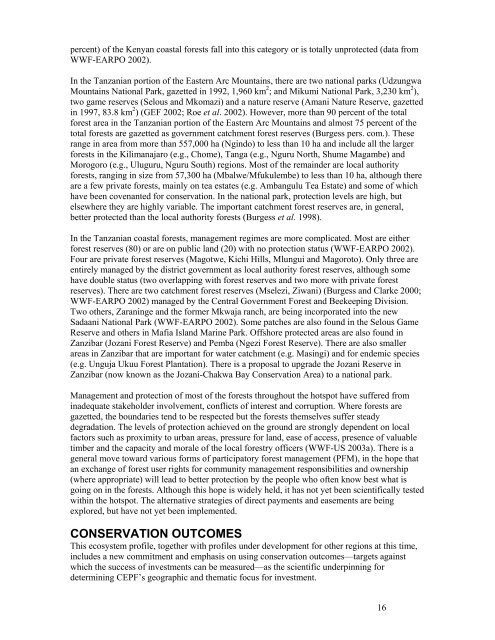Eastern Arc Mountains and Coastal Forests of Tanzania and Kenya ...
Eastern Arc Mountains and Coastal Forests of Tanzania and Kenya ...
Eastern Arc Mountains and Coastal Forests of Tanzania and Kenya ...
Create successful ePaper yourself
Turn your PDF publications into a flip-book with our unique Google optimized e-Paper software.
percent) <strong>of</strong> the <strong>Kenya</strong>n coastal forests fall into this category or is totally unprotected (data fromWWF-EARPO 2002).In the <strong>Tanzania</strong>n portion <strong>of</strong> the <strong>Eastern</strong> <strong>Arc</strong> <strong>Mountains</strong>, there are two national parks (Udzungwa<strong>Mountains</strong> National Park, gazetted in 1992, 1,960 km 2 ; <strong>and</strong> Mikumi National Park, 3,230 km 2 ),two game reserves (Selous <strong>and</strong> Mkomazi) <strong>and</strong> a nature reserve (Amani Nature Reserve, gazettedin 1997, 83.8 km 2 ) (GEF 2002; Roe et al. 2002). However, more than 90 percent <strong>of</strong> the totalforest area in the <strong>Tanzania</strong>n portion <strong>of</strong> the <strong>Eastern</strong> <strong>Arc</strong> <strong>Mountains</strong> <strong>and</strong> almost 75 percent <strong>of</strong> thetotal forests are gazetted as government catchment forest reserves (Burgess pers. com.). Theserange in area from more than 557,000 ha (Ngindo) to less than 10 ha <strong>and</strong> include all the largerforests in the Kilimanajaro (e.g., Chome), Tanga (e.g., Nguru North, Shume Magambe) <strong>and</strong>Morogoro (e.g., Uluguru, Nguru South) regions. Most <strong>of</strong> the remainder are local authorityforests, ranging in size from 57,300 ha (Mbalwe/Mfukulembe) to less than 10 ha, although thereare a few private forests, mainly on tea estates (e.g. Ambangulu Tea Estate) <strong>and</strong> some <strong>of</strong> whichhave been covenanted for conservation. In the national park, protection levels are high, butelsewhere they are highly variable. The important catchment forest reserves are, in general,better protected than the local authority forests (Burgess et al. 1998).In the <strong>Tanzania</strong>n coastal forests, management regimes are more complicated. Most are eitherforest reserves (80) or are on public l<strong>and</strong> (20) with no protection status (WWF-EARPO 2002).Four are private forest reserves (Magotwe, Kichi Hills, Mlungui <strong>and</strong> Magoroto). Only three areentirely managed by the district government as local authority forest reserves, although somehave double status (two overlapping with forest reserves <strong>and</strong> two more with private forestreserves). There are two catchment forest reserves (Mselezi, Ziwani) (Burgess <strong>and</strong> Clarke 2000;WWF-EARPO 2002) managed by the Central Government Forest <strong>and</strong> Beekeeping Division.Two others, Zaraninge <strong>and</strong> the former Mkwaja ranch, are being incorporated into the newSadaani National Park (WWF-EARPO 2002). Some patches are also found in the Selous GameReserve <strong>and</strong> others in Mafia Isl<strong>and</strong> Marine Park. Offshore protected areas are also found inZanzibar (Jozani Forest Reserve) <strong>and</strong> Pemba (Ngezi Forest Reserve). There are also smallerareas in Zanzibar that are important for water catchment (e.g. Masingi) <strong>and</strong> for endemic species(e.g. Unguja Ukuu Forest Plantation). There is a proposal to upgrade the Jozani Reserve inZanzibar (now known as the Jozani-Chakwa Bay Conservation Area) to a national park.Management <strong>and</strong> protection <strong>of</strong> most <strong>of</strong> the forests throughout the hotspot have suffered frominadequate stakeholder involvement, conflicts <strong>of</strong> interest <strong>and</strong> corruption. Where forests aregazetted, the boundaries tend to be respected but the forests themselves suffer steadydegradation. The levels <strong>of</strong> protection achieved on the ground are strongly dependent on localfactors such as proximity to urban areas, pressure for l<strong>and</strong>, ease <strong>of</strong> access, presence <strong>of</strong> valuabletimber <strong>and</strong> the capacity <strong>and</strong> morale <strong>of</strong> the local forestry <strong>of</strong>ficers (WWF-US 2003a). There is ageneral move toward various forms <strong>of</strong> participatory forest management (PFM), in the hope thatan exchange <strong>of</strong> forest user rights for community management responsibilities <strong>and</strong> ownership(where appropriate) will lead to better protection by the people who <strong>of</strong>ten know best what isgoing on in the forests. Although this hope is widely held, it has not yet been scientifically testedwithin the hotspot. The alternative strategies <strong>of</strong> direct payments <strong>and</strong> easements are beingexplored, but have not yet been implemented.CONSERVATION OUTCOMESThis ecosystem pr<strong>of</strong>ile, together with pr<strong>of</strong>iles under development for other regions at this time,includes a new commitment <strong>and</strong> emphasis on using conservation outcomes—targets againstwhich the success <strong>of</strong> investments can be measured—as the scientific underpinning fordetermining CEPF’s geographic <strong>and</strong> thematic focus for investment.16
















